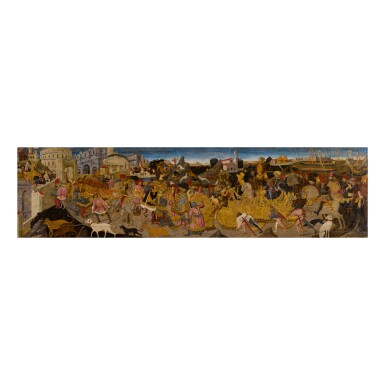Master Paintings
Master Paintings

Property of a Distinguished Collector
APOLLONIO DI GIOVANNI | THE TRIUMPH OF MARCUS FURIUS CAMILLUS, A CASSONE PANEL
Auction Closed
October 14, 03:02 PM GMT
Estimate
200,000 - 300,000 USD
Lot Details
Description
Property of a Distinguished Collector
APOLLONIO DI GIOVANNI
Florence circa 1416 - 1465
THE TRIUMPH OF MARCUS FURIUS CAMILLUS, A CASSONE PANEL
tempera and gold leaf on panel
16¾ by 63⅜ in.; 42.5 by 161 cm.
Collection of Baron Edmond de Rothschild (1845 - 1934), Château de Ferrières;
Seized by the Einsatzstab Reichsleiter Rosenberg from the Chateau de Ferrières (inv. no. BOR 58);
In the holdings of the German Embassy, Paris;
Recovered by the Monuments Men at the Buxheim Monastery, Bavaria, and restituted to the Rothschild family 1946/7 (chest number 134);
From whom probably acquired directly by a private collector, and by descent to his son;
By whom anonymously sold, New York, Sotheby's, 30 January 2014, lot 3;
There acquired.
Apollonio di Giovanni ran a thriving workshop specializing in the production of luxuriously decorated cassoni and spallieri, decorative furniture panels, to meet the demands of elite Florentine patrons. Cassoni were decorative chests customarily commissioned for a marriage, with lavish ornamentation that only the most affluent families could afford. The chests were often carried in pairs as part of the bridal procession, from the house of her father to her new marital home, containing within them items of her dowry, such as linens and cloth. The valuable cassoni were not only intended as extravagant gifts for the initial nuptial celebrations, but they were also envisioned as future heirlooms and were typically displayed in the husband’s bed chamber, one of the most important and intimate rooms in the home.1 The chests would be decorated with scenes from ancient history, the Old Testament, or from contemporary literature, such as Petrarch, Boccaccio or Dante. The episodes depicted were expected to impart a moral message to the couple and their family and the subject would be carefully selected to reflect the family’s intellectual prowess and their personal values.
Apollonio was celebrated for his inventive designs of secular subjects and his treatment of episodes from ancient Roman history, like the present example. 15th century Florentines proudly envisioned themselves as heirs to the democratic values of their Roman forebears and therefore treasured such narratives.2 Here, we see the triumphant return of Marcus Furius Camillus, riding in a standing position in the golden chariot; he can be identified by the remains of the inscription above his head, · M · F · CHAMMI[…]. The spelling of “Chammillus” reflects the soft pronunciation of the letter “c” in Florentine dialect and can be seen again in the inscription indicating the Campidoglio at left. Camillus, a Roman soldier and statesman, was lauded for his four great victories against the Aequi, Volsci, Etruscans and Gauls, and was nicknamed “Second Founder of Rome” for his restoration of power following the sacking of Rome in 390 BC.3 Camillus was not only powerful and victorious but was also fair, introducing pay for his army. Conscious of the struggles of the plebeian class, he was an ideal moralistic model for the groom. The Roman general is preceded in the procession by carriages laden with the spoils of war, a reference to the hopeful prosperity of the newlyweds. Apollonio represents the city of Rome with a typically idiosyncratic approach to topography, juxtaposing its most famed and recognizable monuments, each labelled in an inscription above, in a charming variant of perspective.
1. C. Campbell, Love and Marriage in Renaissance Florence: the Courtauld wedding chests, teachers’ resource, London 2009, p.2
2. Ibid.
3. "Marcus Furius Camillus", in Encyclopaedia Britannica, online academic edition, 2013.
